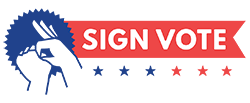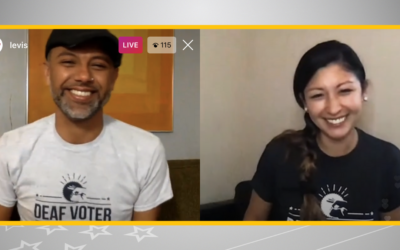Voter Suppression
This was an election unlike any we’ve ever seen before! One of the hot topics was about voter suppression. It isn’t new and it’s not going anywhere.
In the sixth episode of the #SignVote Series: Election 2020, learn what voter suppression is and how it affects us. If you enjoyed this video, please share!
Special thanks to ASLized, DPAN.tv, National Association of the Deaf, and The Center for Democracy in Deaf America!
[TRANSCRIPT with visual descriptions: Video begins with a montage of historical footage of people voting. Text on screen reads: VOTER SUPPRESSION. SignVote logo appears before transitioning to Kriston Pumphrey, a biracial mid-thirties gentleman with short trimmed salt and peppered beard wearing a black polo top and dark gray vest. He sits in front of an animated background. As the video progresses, graphics appear on screen to support his message. Kriston’s message is in American Sign Language and accompanied by voiceover.]
2020 has been fascinating. Many things have happened this year that were disruptive, uncertain, and confusing, especially about the election. In our previous episode, we talked about misinformation and disinformation. In this episode, we are going to discuss voter suppression, what it is, what it looks like, and how it impacts this election. Did you know that certain states, candidates, and parties have been accused of preventing voting opportunities, making it harder for certain groups of people to register to vote in the name of “voter fraud.”
But that doesn’t check out. Researchers and critics, these groups are just making it harder to vote. There’s no real reason for disenfranchising voters, but let’s explain why this is happening.
Based on a recent publication by the Brennan Center for Justice titled, “The Truth About Voter Fraud,” humans have a higher chance of getting struck by lightning than committing voter fraud. Seriously, you’re more likely to get struck by lightning. Even federal government research supports this.
Voter suppression is a particular tactic that aims to prevent specific groups from voting. The goal is to influence the overall results in support of a specific party, candidate, or policy. Throughout the 2020 Coronavirus pandemic, we’ve seen the term “fraud” come up often. Maybe you’ve heard the president talking about it regarding mail-in or absentee ballots. But these have been used long before this pandemic, during the 1918 Spanish Flu outbreak, and even during the civil war. Recently, in the last two federal elections in 2012 and 2016, roughly 1 in 4 Americans voted by mail. Since the early 2000s, over 250 million votes have been cast by mail, and this trend has been growing ever since. Fraud rates have not changed; they remain minuscule.
Voter suppression predominantly impacts people of color compared to white voters. Outside of race, voter suppression seriously impacts women, people who self-identify as transgender, the elderly, students, people with disabilities, low-income households, and those experiencing homelessness. A good example of voter suppression is purging the voter rolls. This means eliminating people’s names from the voter rolls. Each state has a full list of everyone eligible to vote in their state. If done correctly, the purge is meant to ensure that voter rolls are dependable, accurate, and up to date. This means removing duplicate names, people who have recently moved or passed away or are no longer eligible to vote. The process of removing names can cause serious problems, especially when eligible voters show up and discover their names missing from the registry. When this happens, it’s too late, and they can’t vote.
A good example of this happening occurred in 2018 in Georgia. Over 100,000 names were removed from the voter registry, severely impacting black and low-income voters. Their names were just gone. Even some of the people showed up, and a few of them couldn’t vote because the name on the voter rolls didn’t match their ID. For example, the rolls may say Dave, but their ID says, David. The recent example I gave about Dave vs. David is just one of the ways voters are disenfranchised, but there’s more. The purging process can also happen if a voter’s name matches, but their address doesn’t or if their birthday isn’t accurate. They will be removed from the registry. Instead of allowing voters to fix their mistake, they lose the opportunity to vote for that specific election.
Some states have “Use it or lose it” policies in cases where a voter doesn’t vote in the past few elections, they will be removed from the registry. They will then have to start the registration process all over. In April 2019, Oklahoma purged about 88,276 people who hadn’t voted in multiple elections from the voter rolls. Their information was removed just months before the election with no prior warning and without notice. They were given no opportunity to show up and re-register.
Almost all elections are held on a Tuesday. The concept of early voting is meant to give people who may have scheduling conflicts or family obligations or a legitimate reason preventing them from showing up on Tuesday a chance to vote earlier. However, some states try to limit, cut down on, or remove early voting opportunities, which leads to severely long lines and other adverse outcomes. Now, about Voter ID Laws. Some states are very strict and require specific types of ID, making it harder for people to fill out, process, receive, and/or make simple changes on their ID. People who learn at the last minute that they need to make changes find it impossible to do so before an election. That’s one form of suppression.
Another type of suppression applies to people who have been to prison or charged with felonies who aren’t allowed to vote at all. Can you believe that? There’s even more. Such as changing or closing voting locations at the last minute, closing ID offices before an election, spreading false information, intimidating voters, or making it difficult for people to register in the first place.
There are many different types of voter suppression. It’s important to remember and keep in mind that the act of voter suppression is a severe assault on our civil rights laws and a threat to accurate representation in our democratic process. Many people, from generation to generation, have fought for our right to vote today. Right now, our country has a lot of work left to do. One of the most important and simplest things you can take is to vote. Take some time to research your state’s voting laws so you can better understand your rights. Registration and voting should not be complicated. It should be simple.
[Video ends with a SignVote logo and credit roll. Screen fades to black. Video ends.]
[TRANSCRIPCIÓN con descripciones visuales: El video comienza con un montaje de imágenes históricas de personas votando. El texto en la pantalla dice: SUPRESIÓN DE VOTANTES. El logotipo de SignVote aparece antes de la transición a Kriston Pumphrey, un caballero birracial de mediados de los treinta años con una barba corta y moteada vistiendo una polo negra y un chaleco gris oscuro. Se sienta frente a un fondo animado. A medida de que avanza el video, aparecen gráficos en la pantalla para respaldar su mensaje. El mensaje de Kriston está en lenguaje de señas americano y está acompañado de una voz en off.]
El 2020 ha sido fascinante. Han sucedido muchas cosas este año que fueron perturbadoras, inciertas y confusas, especialmente en relación a las elecciones. En nuestro episodio anterior, hablamos sobre la información errónea y la desinformación. En este episodio, vamos a discutir la supresión del voto, qué es, cómo se ve y cómo impacta esta elección. ¿Sabía que ciertos estados, candidatos y partidos han sido acusados de impedir las oportunidades de votar, lo que dificulta que ciertos grupos de personas se registren para votar en nombre del “fraude electoral”?
Pero eso no se comprueba. Según investigadores y críticos, estos grupos solo hacen que sea más difícil votar. No hay una razón real para privar a los votantes del derecho al voto, pero expliquemos por qué está sucediendo esto.
Según una publicación reciente del Centro de Brennan para la Justicia titulada: “La verdad sobre el fraude electoral”, los humanos tienen una mayor probabilidad de ser alcanzados por un rayo que de cometer fraude electoral. En serio, es más probable que te alcance un rayo. Incluso la investigación del gobierno federal respalda esto.
La supresión del voto es una táctica particular que tiene como objetivo evitar que grupos específicos voten. El objetivo es influir en los resultados generales en apoyo de un partido, candidato o políticas específicas. A lo largo de la pandemia del Coronavirus 2020, hemos visto aparecer con frecuencia el término “fraude”. Tal vez haya escuchado al presidente hablar de ello con respecto a las boletas electorales por correo o en ausencia. Pero estos se han utilizado mucho antes de esta pandemia, durante el brote de gripe española de 1918, e incluso durante la guerra civil. Recientemente, en las dos últimas elecciones federales del 2012 y del 2016, aproximadamente 1 de cada 4 estadounidenses votó por correo. Desde principios de la década de 2000, se han emitido más de 250 millones de votos por correo, y esta tendencia ha ido en aumento desde entonces. Las tasas de fraude no han cambiado; siguen siendo minúsculas.
La supresión del voto afecta predominantemente a las personas de color en comparación con los votantes blancos. Fuera de la raza, la supresión del voto afecta seriamente a las mujeres, las personas que se identifican a sí mismas como transgénero, los ancianos, los estudiantes, las personas con discapacidades, los hogares de bajos ingresos y las personas sin hogar. Un buen ejemplo de la supresión del voto es la depuración de las listas de votantes. Esto significa eliminar los nombres de las personas de las listas de votantes. Cada estado tiene una lista completa de todas las personas elegibles para votar en su estado. Si se hace correctamente, la purga tiene como objetivo garantizar que las listas de votantes sean confiables, precisas y estén actualizadas. Esto significa eliminar nombres duplicados, personas que se han mudado o fallecido recientemente o que ya no son elegibles para votar. El proceso de eliminación de nombres puede causar serios problemas, especialmente cuando los votantes elegibles se presentan y descubren que sus nombres faltan en el registro. Cuando esto sucede, ya es demasiado tarde y no pueden votar.
Un buen ejemplo de esto ocurrió en el 2018 en Georgia. Se eliminaron más de 100.000 nombres del registro de votantes, impactando severamente a los votantes negros y de bajos ingresos. Sus nombres simplemente habían desaparecido. Incluso algunas personas se presentaron, y algunas no pudieron votar porque el nombre en las listas de votantes no coincidía con su identificación. Por ejemplo, las listas electorales pueden decir Dave, pero la identificación dice, David. El ejemplo reciente que di sobre Dave contra David es sólo una de las formas en que los votantes están privados de sus derechos, pero aún hay más. El proceso de depuración también puede ocurrir si el nombre de un votante coincide, pero su dirección no o si su fecha de nacimiento no es exacta. Se eliminarán del registro. En lugar de permitir que los votantes corrijan su error, pierden la oportunidad de votar por esa elección específica.
Algunos estados tienen políticas de “Úselo o piérdalo” en los casos en que un votante no vota en las últimas elecciones, será eliminado del registro. Luego tendrán que comenzar el proceso de registro desde el principio. En abril del 2019, Oklahoma eliminó de las listas de votantes a unas 88,276 personas las cuales no habían votado en múltiples elecciones. Su información fue eliminada pocos meses antes de las elecciones sin aviso previo y sin notificarse. No se les dio la oportunidad de presentarse y volver a registrarse.
Casi todas las elecciones se celebran en Martes. El concepto de la votación anticipada está destinado a brindar a las personas que puedan tener conflictos de programación u obligaciones familiares o una razón legítima que les impida presentarse el Martes, la oportunidad de votar antes. Sin embargo, algunos estados intentan limitar, recortar o eliminar las oportunidades de votación anticipada, lo que genera filas muy largas y otros resultados adversos. Ahora, sobre las leyes de identificación de votantes. Algunos estados son muy estrictos y requieren tipos específicos de identificación, lo que dificulta que las personas completen, procesen, reciban y / o realicen cambios simples en su identificación. Las personas que se enteran hasta en el último minuto de que necesitan hacer cambios encuentran imposible hacerlo antes de las elecciones. Ésa es una forma de represión.
Otro tipo de represión se aplica a las personas que han estado en prisión o acusadas de delitos graves a las que no se les permite votar en absoluto. ¿Puedes creerlo? Y aún hay más. Como cambiar o cerrar lugares de votación en el último minuto, cerrar oficinas de identificación antes de una elección, difundir información falsa, intimidar a los votantes o dificultar que las personas se registren en primer lugar.
Hay muchos tipos diferentes de supresión de votantes. Es importante recordar y tener en cuenta que el acto de supresión de votantes es un ataque severo a nuestras leyes de derechos civiles y una amenaza para la representación precisa en nuestro proceso democrático. Muchas personas, de generación en generación, han luchado por nuestro derecho al voto hoy. Ahora mismo, a nuestro país le queda mucho trabajo por hacer. Una de las cosas más importantes y sencillas que puedes hacer es votar. Tómese un tiempo para investigar las leyes de votación de su estado para que pueda comprender mejor sus derechos. El registro y la votación no deberían ser complicados. Debería ser sencillo.
[El video termina con un logotipo de SignVote y una lista de créditos. La pantalla se vuelve negra. El video termina.]




